Vtime Oculus Go Upload Document to Use in Meeting Room
In the wake of the global Coronavirus (COVID-19) pandemic, immersive technologies accept been thrust into the limelight as a potential solution to organisations of a sudden finding themselves having to enforce working from home for their employees, or seeing events and travel arrangements cancelled. As a result there is a mixed bag of coverage effectually the viability of VR for remote work and collaboration use cases.
Ane use case for VR that has been growing in popularity and capability over the past few years has been around multi-user, social platforms, allowing users to meet in lodge to piece of work and play together within their headsets from home or the role. Some platforms are focused more on the ability to enable virtual social gatherings, whereas many other target specific areas of piece of work, such as remote collaboration, reviewing models or holding meetings.
Beyond just the potential immediate need with the requirement in many countries for remote, home working, at that place are many other benefits to these platforms that will hopefully get apparent to yous whilst reading through the listing. Let's take a look at some of the cardinal benefits:
- Saving fourth dimension and money – past not having to travel to locations to encounter in person face-to-face, and so the fourth dimension for the meeting is within that window but without the toll of travelling to some other physical location, particularly benign if this is in some other city, or even another country.
- Reducing carbon footprint – linked to the beginning indicate, if you lot're non travelling to physical locations, y'all're non contributing to CO2 emissions by using a form of transport.
- Sense of presence – multi-user spaces permit more connection to one another through interactions, gestures and recognisable avatars, over a flat video call.
- Interactive elements – we can piece of work together around a virtual whiteboard or bring other digital documents into the infinite for review, such as presentations, PDFs and videos.
- Distraction free – when we're fully immersed in VR, we are concentrating on one thing and one matter only, the reason we are in VR, without second screens or other people distracting or interrupting usa.
- Real globe filter – when we're in a virtual space, we don't have to worry about what else the video photographic camera is picking up and transmitting to other viewers (i.east. messy rooms).
- Custom 3D avails – nosotros can bring our ain 3D models into the VR space for review, collaboration or increasing presence and relevancy.
- Reduced bandwidth usage – many of the apps are built using game engines like Unity and Unreal, the data requirement is much lower since all that is beingness transmitted betwixt users is each positional information coordinates, and audio on a divide aqueduct. Therefore dissimilar video conferencing, which suffers horribly when bandwidth is limited or data packets are lost in manual, since the total frame of every video has to be transmitted and missing data means choppy audio, visual artefacts, drib in resolution and more than, social VR apps are far more stable whilst using less bandwidth; disquisitional in a time when demands are much college than usual, with everyone wanting bandwidth at home to work, sentry and play.
Whilst fourth dimension and the slower-than-expected growth of the VR manufacture and wider-adoption beyond merely gaming uses hasn't been kind to everyone, there are a number of viable options that cover most VR hardware platforms available, depending upon your specific need.
Although video conferencing to generally deemed easier, since almost people (inside the target grouping of users,) have admission to a work laptop and/or mobile phone to use, many of the VR applications listed below also take a web or desktop client mode, so you don't always need a VR headset to admission.
Some of these are available now for gratis access, with or without premium subscription options, some are smaller, fledgling tools that we have had the opportunity to test out privately ahead of launch, some are merely available direct through the studio creating them on a commercial subscription basis. Finally, some aren't actually available yet, or you lot can pre-register a sign-up but ultimately worth including in the list for awareness purposes.
Note that we are only looking at shared VR spaces and applications that enable remote collaboration, not shared VR hardware similar projection domes etc, that allow multiple people in the same infinite; these are not useful in regards to abode working and flattening the curve. Also annotation that whilst they say a picture says a g words, for many of the applications listed below that permit customisation of avatars, the worlds and more, the singular image chosen is not always fully representative of the experience.
Social Spaces
AltspaceVR
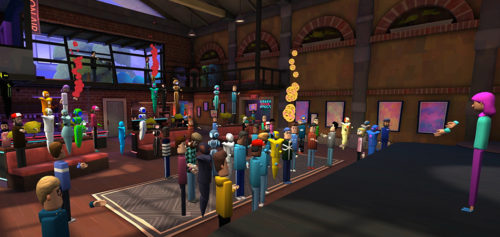
Originally founded in 2013 with the initial product launched in 2015, AltspaceVR nearly became one of the most-rans until Microsoft acquired the platform in 2017. Since then, AltspaceVR has seen a growth in users and uses, with a strong, supportive community built up around collaborative learning, sharing of knowledge and of course, being social and hanging out.
AltspaceVR was recently one of the main leading platforms supporting the 'Educators in VR International Summit' result, a 6-day long virtual outcome hosting over 170 speakers across a range of topics from education to blueprint and development to wider philosophical musings on and effectually the immersive technology sectors. Y'all tin read a very lengthy, detailed write-up of the event from the organisers with lots of lessons learned for anyone else thinking of using VR social platforms for organising events online.
The platform also allows power users to create their ain rooms within the system to customise the spaces to their needs – a getting started guide points budding virtual worlds builders in the right direction. Some pre-configured rooms allow for presenters or room admins to have command over a big presentation screen and pull external presentations from slides.com into the session for all attendees to encounter.
Attendees are represented by cute, blocky characters with a degree of customisation for free with additional cosmetic items bachelor for a cost, beyond the human and robot based options.
AltspaceVR is widely supported by all the major platforms and VR hardware devices, including: Oculus Rift, Oculus Get, Oculus Quest (via SideQuest), HTC Vive and Windows MR headsets. If you do non have access to 1 of those VR headsets, and so there is also a 2D desktop version available.
Mozilla Hubs
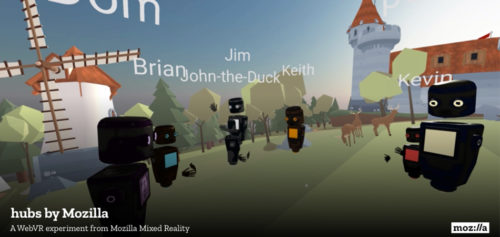
From the same company behind the Firefox web browser, Mozilla Hubs builds upon the growing capabilities of webXR standards, by creating a virtual world platform that technically needs zip installed prior to joining in online. Through Mozilla's ain creation and scripting tool Spoke, users are able to create content hands for utilize within the worlds for your customisation needs. Existence webXR based, it currently looks a little more unproblematic than others in visual manner and capabilities but the benefit of this is that anyone tin hop in from a mobile telephone browser to a desktop to a broad range of mobile to standalone and full VR headsets. Once a room is created, a elementary code link can be shared to quickly bring other users into that space without requiring huge downloads.
Sansar VR

Whilst the Sansar VR platform has simply been around for a couple of years, the developers and owners Linden Lab are well known for their earlier, highly popular virtual worlds platform Second Life (which is nonetheless going potent today, just not with VR support). Similar Second Life, Sansar is looking to create a metaverse with technically impressive avatar customisation and full-trunk tracking and representation in-world, but also like Second Life, there are adult-orientated areas that enterprise users should be aware of before letting employees freely roam unguided.
The platform also allows custom worlds to exist created with admission controls bachelor but this time there is more emphasis on graphical quality and fidelity of the spaces, reducing the current supported VR hardware down to tethered PC VR headsets only, similar Oculus Rift, HTC Vive and Windows MR devices. Popular public worlds with users tend to fall into the technolust, '90s cyberpunk, sci-fi styled spaces, where everything is very dark and gritty, or based upon popular sci-fi Boob tube serial but the world creation procedure empowers you lot to make your worlds to your liking or needs.
Similarly, the avatars are typically far more realistic where users are looking to build online personas they grow and embody over the years, with full-bodies represented in high fidelity models that can be rigged for mo-cap alive input from the real world user.
Some other social VR platform that also sprung from ex-founders of Linden Lab, chosen High Fidelity, unfortunately shut it'south virtual doors a few months ago in gild to refocus and reassess it's position within the virtual space. Aimed much more at education and collaboration, information technology'south a neat shame to see the platform shutter at this stage of headset adoption.
Somnium Space
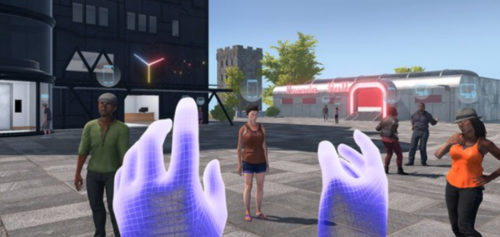
A relatively new entry into the social VR space, Somnium Space is built upon blockchain to create a persistent, user-owned globe, looking to challenge the concepts of virtual land buying similar to Second Life and Sansar. Through the use of crypto-currencies, it allows users to create and upload 3D assets to sell to other users for their avatars, homes or own worlds they are building.
The desktop client appears to offer a powerful world-edifice tool to create realistic or fantasy worlds every bit desired. VR back up is limited to PC VR headsets like Oculus Rift, HTC Vive and Windows MR devices currently, but standalone headset support is planned.
A apace growing community effectually the space is already establishing regular news updates, assistance for newcomers, knowledge sharing and welcoming those who wish to explore the possibilities of virtual land buying; some large names have already started to create their presence within the world for a new level of virtual presence and persistence.
Rec Room
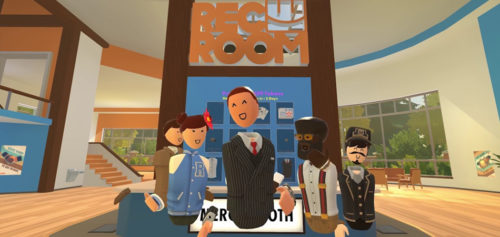
Popular with the kids and adults alike, Rec Room is very much aimed at the fun side of life, with more social, multiplayer games than meetings, but that's not to say a private room for a meetup cannot be created and it could be fun to exercise some light amplification by stimulated emission of radiation tag or treasure hunts in-between presentations to help alleviate the colorlessness of being stuck indoors.
The avatar manner is alike to AltspaceVR with floating heads and easily and cartoony bodies, but the platform support includes Sony PlayStation VR headsets, which is the highest selling VR headset currently with over 5m units sold. At that place'due south a loftier chance one of your employees might accept bought one of these for their children (or themselves, which is too perfectly acceptable) and could requisition information technology for working at home remote meeting purposes.
Bigscreen
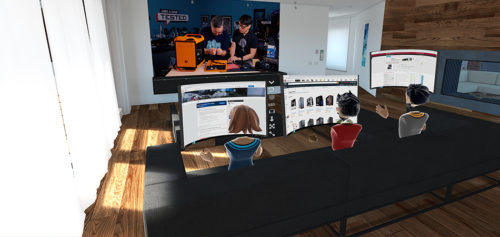
Whilst technically a shared-viewing platform, over again in that location's no reason why you couldn't make apply of Bigscreen and the social capabilities to meet upward in VR. Users can share their desktop screen for a individual room of users to see, and then you could scout back online talks and presentations from events together, or review video trailers or just take a break and watch that volleyball flick. Bigscreen is also bachelor for all main popular VR headsets.
vTime
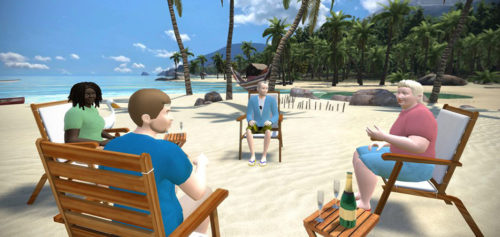
Designed for smaller groups of four users, vTime supports Oculus Rift and many older mobile VR platforms, if you still have ane of those knocking most.
VR Chat
Whilst accurate numbers are widely shared or known, it is mostly believed that VR Conversation is the largest virtual worlds platform with the most users just the majority of these are coming from the 2D desktop version. Also in regards to suitability for work purposes, although it was purchased by HTC Vive, being completely open up with a large user base, information technology may not be entirely suitable for utilize, with users able to upload any 3D model as their avatar, you will typically be faced with an regular army of anime drawing characters and other copyright-infringing avatars; think The Haven scenes from Gear up Role player One. You are able to create your own individual spaces however to maintain focus on work.
Loco Dojo
OK you lot can call us out for bias with this one *just* we have used our social multiplayer game Loco Dojo for meetings! Supporting upwards to four players around the metagame tabular array with VOIP enabled, it's possible to hold a remote meeting and if decisions become heated, use one of the sixteen minigames to settle the event! Available for Oculus Rift, HTC Vive andWindows MR devices with Sony PlayStation VR, Oculus Quest and Vive Focus Plus builds available if y'all ask nicely.
Facebook Horizon
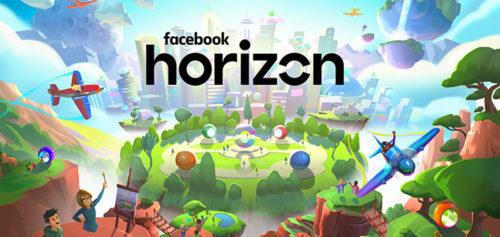
Appear at Oculus Connect 6 (OC6) in 2019, Facebook Horizon is the bigger sibling of their initial forays into shared, social spaces, mixing lessons learned from Facebook Spaces, Oculus Rooms and Oculus Venues, plus all the skilful customisation, world-edifice aspects, into a singular virtual platform. Still at nowadays, you can merely register interest and no public beta has been announced at this stage only nosotros expect something to exist bachelor to users at some stage in 2020.
So these are the principal social space contenders currently available for nigh VR headsets, but there are also a number of emerging platforms and solutions built around specific enterprise and business organisation use cases, primarily at shared learning, meetings and collaboration.
Instruction & Learning
Engage

The Engage platform, from our friends over at Immersive VR Pedagogy, (known originally for the Apollo eleven and Titanic VR experiences,) is aimed very much more than at the education space, allowing teachers, students and users to create their own worlds full of a large library of 3D avails for knowledge sharing and learning.
However it has been successfully been used for meetings and conferences, with pioneering leader of virtual education Steve Bambury running #CPDinVR series of meetups there for a number of years now, and recently HTC Vive have appear that they are going to be using the platform for their next worldwide outcome. The platform makers are looking to branch out into enabling users to create training scenarios within the organisation; a number of example demonstrator concepts can be plant on the website.
Like Sansar, Engage aims for the more realistic avatar representation with total body motion-tracking for one:1 avatar blitheness and motility, based upon user inputs. The platform offers a powerful avatar creation tool where users can upload a 2d photograph of their confront to map onto their 3D avatar for that more lifelike look.
Engage supports a wide range of VR headsets, from Oculus Rift and Oculus Quest (over again through SideQuest), the HTC Vive family of devices as well every bit Vive Focus, and the usual range of Windows MR headsets through SteamVR. Like AltspaceVR, there is a 2d non-VR desktop client bachelor every bit well.
Meetings & Collaboration
Spatial
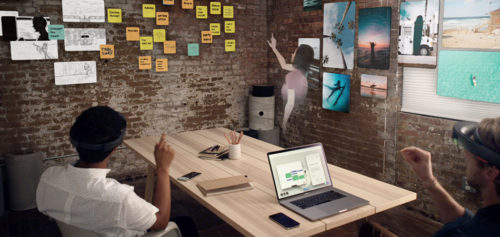
Outset upward is a change to all the others so far in that Spatial is aimed at AR headset users (i.east. HoloLens and Magic Leap) and therefore with current adoption levels of these devices, is probable to exist out of reach of many users. However they are accepting sign-ups and enabling access in controlled roll-out over time and so if you practise accept one of these devices available, be sure to bank check it out. The benefit of being AR-based is that you can mix and match use cases, with some people in the same room physically together augmenting the space around them with holographic representations of remote co-workers nowadays as well. Currently the complimentary level of access, once granted, supports up to 4 users for a 45 minute session, whereas the enterprise options scales upwards to 12 people with unlimited time and rooms.
Immerse
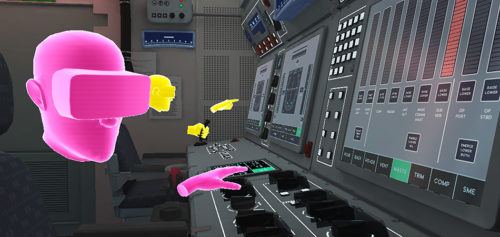
Our good friends over at Immerse are building a name for themselves with their collaboration and data-collection Virtual Enterprise Platform (VEP) for VR. Aimed more at grooming, learning and evolution and simulation than meetings or presentations, they are focused on creating the underlying layer that connects content and user data to existing direction systems, to help ensure validation of efficiencies and effectiveness is possible, enabling stakeholders to prove their KPIs driving ROI for immersive technologies within learning. For users without VR, a uncomplicated web link organisation provides quick and like shooting fish in a barrel access for desktop viewing of a session.
VisionXR
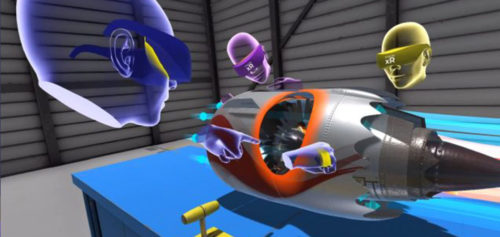
Similarly, our local VR dev cohorts Future Visual, whilst keeping some things close to their chests at the moment, are building out VisionXR, a multi-user collaboration platform that impresses with early on videos of the range of devices supported, from VR to AR to tablet to desktop and browser, to ensure access is not limited to the headset. They currently offering a service where you can upload your own content or a managed, custom choice where bespoke content tin be created for you.
Rumii
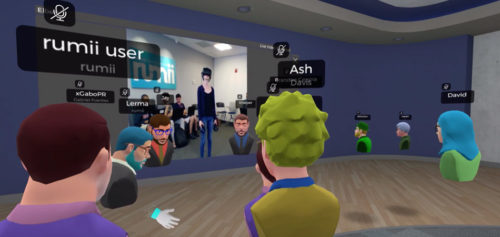
Enterprise-focused Rumii from Doghead Sims has a variety of options from a directly-forward turnkey solution that gets users upward and running apace out of the box, to bespoke white label versions that can be customised to your branding or an entirely custom solution that can be created to incorporate specific apply cases and needs accordingly. Currently supports PC VR headsets and Oculus Go, with a PC, mobile and Mac desktop version available too.
Glue
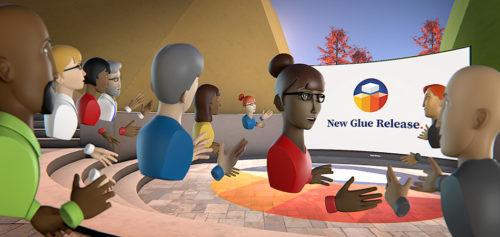
Recently updated with a slew of new features and user improvements, Mucilage looks very professional person, offer expected enterprise-focused criteria such as security of data, customisation, persistence of rooms and assets, and file support. However equally a upshot, access is simply available via a bookable demo or direct contact to the sales team, who will expect to provide access equally SAAS rather than a platform y'all tin can rapidly hop into just this is fairly standard for many of the enterprise solutions.
MeetinVR
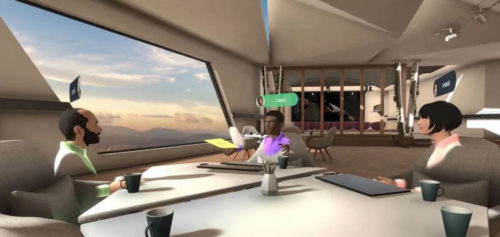
Currently inviting users to the early access period, MeetinVR is shaping up to be a quality platform for meetings, talks, presentations, interviews and collaboration. We were recently invited to be interviewed using the organisation and came away impressed with the platform evolution and tools available, with bespoke avatars created for u.s.. Expected VR headset support covers the main devices, including HTC Vive, Oculus Rift, Go and Quest, Windows MR and more to be appear.
MeetingRoom.io
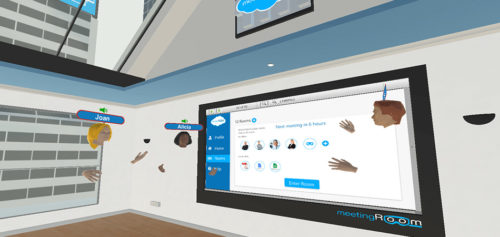
Aimed purely at virtual meetings, MeetingRoom provides a range of levels of service depending upon your organisation size and needs. For a straight-forward solution with base tools like whiteboard, the ability to display a wide range of file formats, information technology's a distraction-complimentary manner to hold a virtual meeting online. 2d Desktop and PC VR versions are available directly with versions for standalone devices similar Oculus Go and Quest, Pico and Vive Focus are bachelor upon request (likely considering these need to be sideloaded with assist).
Dream
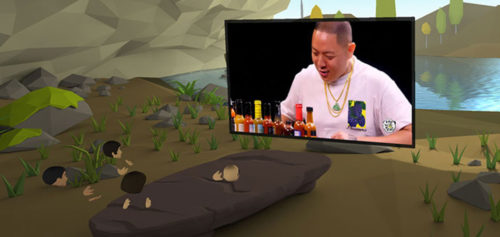
Offer meeting, collaboration and shared desktop features, Dream is available for PC VR headsets (Oculus Rift and HTC Vive) with Google Drive, Dropbox and YouTube integration, along with an embedded spider web browser, all of which tin can exist positioned within multiple virtual windows within the virtual world space.
ImmersedVR
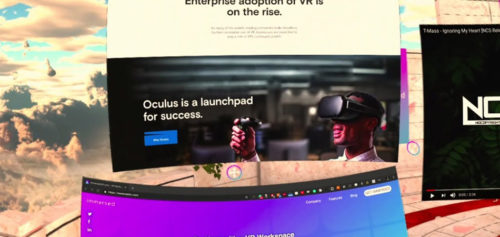
Another solution that allows you to bring virtual monitors into the virtual space for collaboration is ImmersedVR, available on Oculus Go and Quest, with a range of fairly low pricing options per user.
Vive Sync
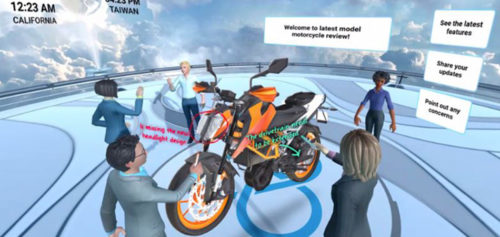
Appear dorsum in 2018 just recently pushed to the forefront of attending, Vive Sync is a collaboration tool for enterprise users of HTC Vive VR hardware beyond their broad spectrum of products, from HTC Vive, Vive Pro, Vive Pro Middle, Focus+ and the modular Cosmos system. Based upon the enterprise offerings from Vive it is a secure gateway into virtual worlds for users of Vive products, with integrated Microsoft OneDrive support for bringing your files into VR.
Blueprint Reviews
Sketchbox

Offer powerful 3D object and scene creation tools, Sketchbox started off as a greyboxing prototype tool that added multi-user back up and now allows users to collaborate and work together to blueprint, build and review in VR. OBJ formats can be imported in whilst FBX files can exist exported out for use in Unity and Unreal. Currently supports PC VR headsets similar Oculus Rift, HTC Vive and Windows MR devices.
Improov
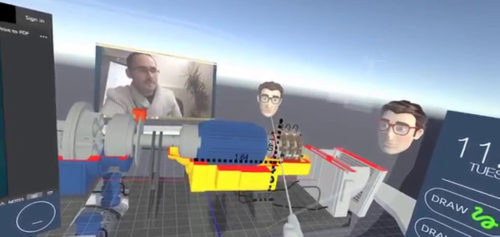
Aimed at CAD designers, Improov by MiddleVR, enables users to carry out collaborative pattern reviews, piece of work on maintenance and assembly processes nearly, determine best layouts and ergonomic assessments. Supporting all the major CAD files, focus is on accurateness and particular not necessarily performance (these are heavy, unoptimised files for VR, although they have a 3D model streaming system) supporting the usual range of tethered PC VR headsets (requiring the graphical power for CAD) merely also caves, multi-aqueduct project systems, 3D TVs and a variety of tracked add-ons.
InsiteVR
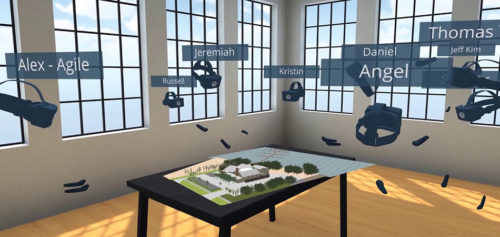
Aimed at the AEC space supporting BIM360, Navisworks, Revit and SketchUp models, InsiteVR is another collaborative enterprise tool for professional designers, supporting HTC Vive, Oculus Rift & Quest, Windows MR with a desktop client also available. Forth with viewing files together, users are able to track problems found and highlighted and output PDF reports from sessions.
Masterpiece
Planting squarely in the creative space, Masterpiece VR is a powerful 3D VR creation tool that supports multiple users to piece of work together. It's rapidly growing to add more tools and features to the base set of 3D modelling capabilities, including skeletal rigging and blitheness configurations all in realtime, in VR together. Currently supporting PC VR headsets, the fully paid options provide 3D modelling capabilities yous would typically expect to find in professional offline, desktop-based modelling software.
The Wild
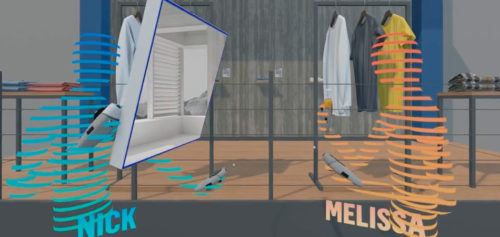
Also aimed more at the AEC sectors, The Wild enables users to import their SketchUp, Revit and BIM360 models to review together, utilising the power of VR to experience 3D models and designs at 1:1 scale. Collaborators can join in from a range of VR headsets including Oculus Rift and Quest, HTC Vive, Windows MR, AR clients and desktop (PC & Mac). The avatar representations are some of the most visually, stylistically pleasing variants to the middle we've seen.
IrisVR
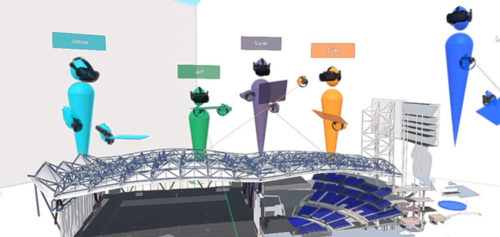
Some other powerful AEC-focused solution, IrisVR offers integration with Navisworks, Revit, Rhinoceros and SketchUp database files. VR headset back up is wide with PC VR systems such as Oculus Rift, the HTC Vive family, Windows MR, Pimax and Valve Index (all through the SteamVR integration no doubt) as well standalone devices similar Oculus Quest. With a heavy CAD characteristic fix, the individual pricing options are on the slightly higher end compared to other solutions.
Foresight
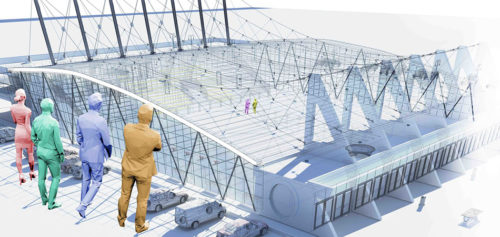
Allowing multi-user virtual viewing of backdrop, Foresight from local company Percept Imagery, looks to make AEC viewing simple and easy for users, with deployment using 5G to stream high quality 3D/BIM data avails to headsets without big awarding downloads to depression cost headsets, like Oculus Become.
Phew that'southward quite a list; at that place are still many more options and solutions bachelor but these are the ones that nosotros felt were worth looking at and because, based upon their availability, maturity and professionalism (in well-nigh cases…). Am sure at that place is something there that will enable you and your squad to detect ways of immersing yourselves in work, improving workflows and exploring unique employ cases for VR effectually remote working. Permit the states know how you get on!
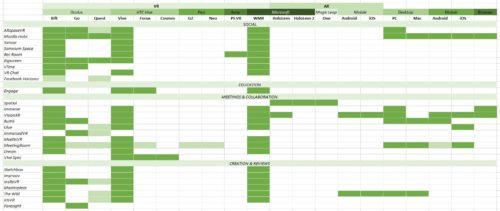
Source: https://makereal.co.uk/using-immersive-technologies-for-remote-working/
0 Response to "Vtime Oculus Go Upload Document to Use in Meeting Room"
Publicar un comentario